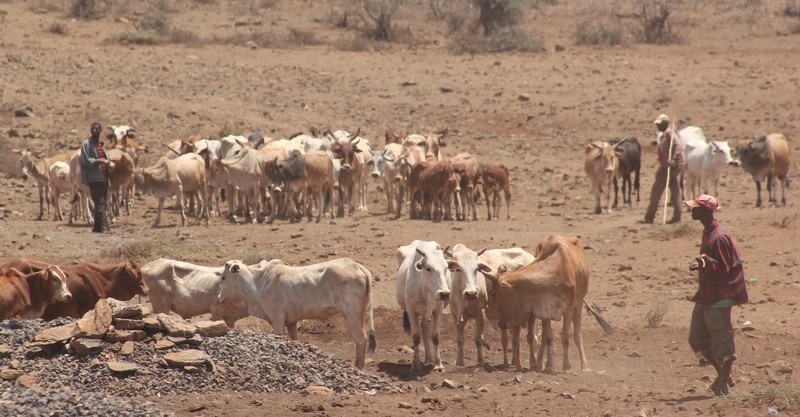
GRAIN is a small international non-profit organisation that works to…
Read Next
Academics who work closely with pastoralist communities through the PASTRES research programme have issued a cry in the dark for nuance and rebalancing in the global debate about meat, dairy and climate. We want to support and echo their call, as it’s crucial to get the messaging and the action right.
For more than ten years, GRAIN has been working to expose the role of the industrial food system in driving the climate crisis – and the role of peasant food producers, agroecology and local markets in turning it around. Over that period, a lot has changed. In the past, when trying to understand what’s causing climate change, after transport and energy, governments only looked at agricultural production, ignoring the wider series of events that enable most people to eat every day. Today, people are looking at food systems per se, a much smarter approach. In 2007, the International Panel on Climate Change said that agriculture contributes 10-12% of overall annual greenhouse gas emissions while today it says that food systems cause up to 37%.
We have also grown a lot more aware of the outsized role that the meat and dairy industry plays in producing emissions. The problem, so it is said, lies mainly with ruminants, like cattle, that naturally let off methane as they digest food. (Methane heats the climate way more than carbon dioxide but only sticks around for a short time.) This has put beef and dairy at the centre of discussion. But they are not really the problem, as we have tried to show. The problem is industrial meat and dairy. That means the multinational companies that have turned livestock into a global commodity, the food and retail chains that market them, the government subsidies that make them cheap and the plethora of trade agreements that (de)regulate the markets for these companies.
As the group at PASTRES shows, this distinction has been ignored. Policymakers, celebrities, rich people and activists are talking about meat and dairy as the problem, not paying attention to the difference between industrial and the rest. Yet, the difference is crucial. Worse still, the demonisation of meat and dairy, in general, has unleashed a new corporate and capitalist stampede to make money from alternative proteins, be they plant-based or laboratory creations.
Wrong diagnosis, wrong remedy
The PASTRES researchers point out that if you don’t frame the problem carefully, you won’t come up with the right solutions. They argue convincingly that the livestock/climate debate is built on a biased and imbalanced set of data that denies a nuanced and complex understanding of pastoral livestock systems. The problems with the data lead to conclusions and policy options that favour industrial livestock – which only looks better through a hyper-reductionist lens of “efficiency”, where the unit of a single output (methane) per a specific input (protein) is all that matters. The multiple benefits that pastoral and extensive livestock systems provide are left out of the equation, as are all the negative externalities that flow from industrial livestock systems. So, too, is the crucial question of consumption: if the global supply of meat and dairy has to be reduced, how will the remaining supply be distributed, and who will produce it?
Here we are in complete agreement with PASTRES that reductions in consumption must be made first and foremost by the small portion of the global population that is over-consuming meat and dairy. But we also believe that the reduction in consumption must correspond to a reduction in production in those parts of the world that are over-producing meat and dairy, which tend to overlap. Countries like the US and the Netherlands need to cut back on their meat and dairy consumption, and reorganise their farming systems accordingly, not boost exports. Other countries, like Kenya or Haiti, have some room to grow their consumption – which should be supplied by local systems of meat and dairy production, not imports.
Global meat and dairy production is currently dominated by a handful of corporations who have production bases in a few surplus producing countries where livestock farms are heavily industrialised and dependent on fossil fuels. Despite their pledges to take action on the climate, they continue to plan for growth and to lobby hard against any measures that would curtail their production and sales. They are the biggest obstacles to actions that can effectively reduce emissions from livestock and that can get us to a place where consumption and production are equitable and healthy for people and the planet.
Moving forward
It is good that more and more people are paying attention to the role our food systems play in the current climate crisis. But we have to get smarter in seeing that the real problem is corporate power and the capitalist drive to overproduce and over-consume. The problem is Tyson, JBS, Danone, Nestlé, WH Group, CP Foods and Cargill – and the banks, billionaires and pension funds fuelling their operations. These are the real culprits, not cattle!
It’s high time we mount a concerted fight to bring the industrial food system down and empower local producer communities instead.
Subscribe now for updates from Msingi Afrika Magazine!
Receive notifications about new issues, products and offers.
What's Your Reaction?
 PIN IT
PIN ITGRAIN is a small international non-profit organisation that works to support small farmers and social movements in their struggles for community-controlled and biodiversity-based food systems



















